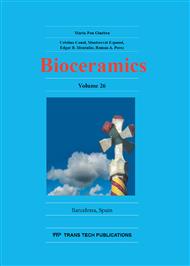[1]
A. Ravaglioli, A. Krajewski, Bioceramics materials, properties, applications, London, 292-300.
Google Scholar
[2]
P.O. Kroon, M.A.R. Freeman, Hydroxyapatite Coating of Hip Prostheses, J Bone and Joint Surg [Br], 74B (1992) 518-22.
Google Scholar
[3]
C.P.A.T. Klein, P. Patka, H.B.M. Van der lubbe, C.G.J. Wollie, Plasma sprayers coating of tetracalcium phosphate, hydroxyapatite and α-TCP on titanium alloy; an interface study, J Biomed Mater Res 25 (1991)53.
DOI: 10.1002/jbm.820250105
Google Scholar
[4]
Z.A. Monroe, W. Votawa, D.B. Bass, New calcium phosphate ceramic material for bone and tooth implants J. McMullen, J. Dent. Res. 50 (1971) 860-2.
DOI: 10.1177/00220345710500041201
Google Scholar
[5]
R.Z. LeGeros, Calcium Phosphate Materials in Restorative Dentistry: A Review, Adv Dent. Res, 2 (1988) 164-83.
DOI: 10.1177/08959374880020011101
Google Scholar
[6]
N. Demirkol, F.N. Oktar, E.S. Kayali, Influence of commercial inert glass addition on the mechanical properties of commercial synthetic Hydroxyapatite, Acta Phys. Pol. A 123 ( 2013) 427-429.
DOI: 10.12693/aphyspola.123.427
Google Scholar
[7]
J.W. Choi, Y.M. Kong, H.E. Kim, I.S. Lee, Reinforcement of hydroxyapatite bioceramic by addition of Ni3Al. and Al2O3, J. Am. Ceram. Soc. 81(7) (1998) 1743-1748.
DOI: 10.1111/j.1151-2916.1998.tb02543.x
Google Scholar
[8]
E. Fidancevska, G. Ruseska, J. Bossert, Y.M. Lin, A.R. Boccaccini, Fabrication and characterization of porous bioceramic composites based on hydroxyapatite and titania, Mater. Chem. Phys. 103 (2007) 95-100.
DOI: 10.1016/j.matchemphys.2007.01.015
Google Scholar
[9]
I. Mobasherpour, M.S. Hashjin, S.S.R. Toosi, R.D. Kamachali, Effect of the addition ZrO2–Al2O3 on nanocrystalline hydroxyapatite bending strength and fracture toughness, Ceramics International 35(4) (2009) 1569-1574.
DOI: 10.1016/j.ceramint.2008.08.017
Google Scholar
[10]
Z. Evis, Hydroxylapatite-Zirconia Composites, Ceramics International 33 (2007) 987-991.
DOI: 10.1016/j.ceramint.2006.02.012
Google Scholar
[11]
Z. E. Erkmen, F.N. Oktar, Y. Genç, Microstructural and Mechanical Properties of Hydroxyapatite - Zirconia Composites, J. Am. Ceram. Soc. 90 (2007) 1-8.
DOI: 10.1111/j.1551-2916.2007.01849.x
Google Scholar
[12]
S.K. Kim, J.H. Lee, Y.T. Kim, D.H. Riu, S.J. Jung, Y.J. Lee, S.C. Chung and Y.H. Kim, Synthesis of Si, Mg substituted hydroxyapatites and their sintering behaviours, Biomaterials 24 (2003) 1389-1398.
DOI: 10.1016/s0142-9612(02)00523-9
Google Scholar
[13]
F.N. Oktar, S. Agathopoulos, L.S. Ozyegin, O. Gunduz, N. Demirkol, Y. Bozkurt, S. Salman, Mechanical properties of bovine hydroxyapatite (BHA) composites doped with SiO2, MgO, Al2O3, and ZrO2, J. Mater Sci: Mater Med. 18 (11) (2007) 2137-43.
DOI: 10.1007/s10856-007-3200-9
Google Scholar
[14]
British Standard Non-Metallic Materials for Surgical Implants. Part 2 Specification for ceramic materials based on alumina, BS 7253: Part 2: 1990 ISO 6474-(1981).
Google Scholar


